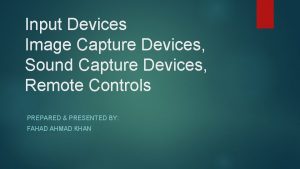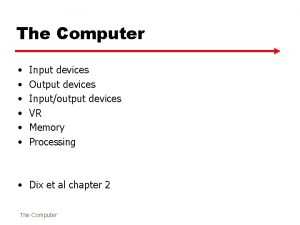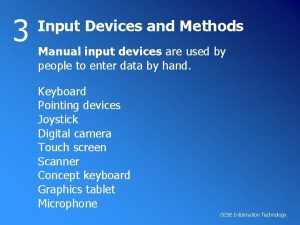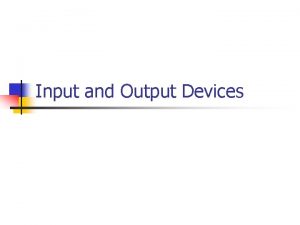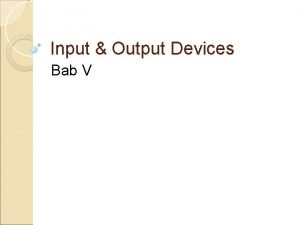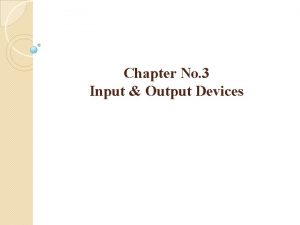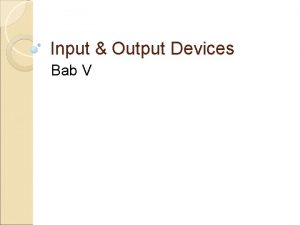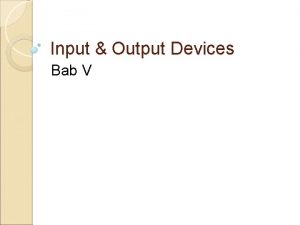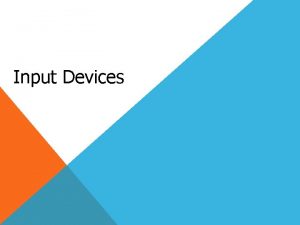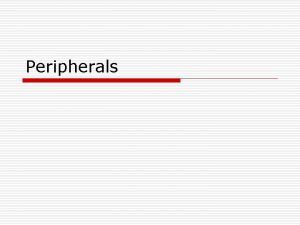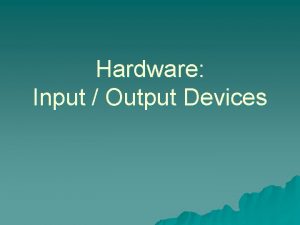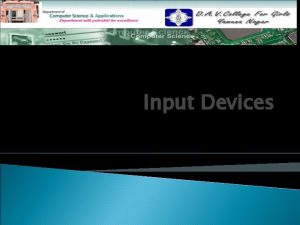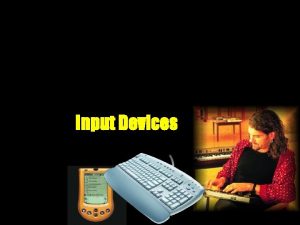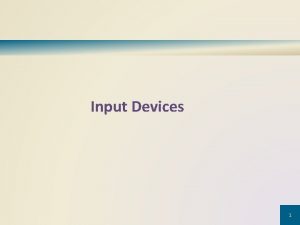Input Devices and Theory Input for Selection and


































- Slides: 34

Input: Devices and Theory

Input for Selection and Positioning n n n Devices Power Law of Practice Fitt’s Law (2 D, 3 D lag) Eye hand coordination Two handed Methods and Metaphors

5 Virtual Devices. Adapted from Wallace, 1976. "The Semantics of Graphic Input Devices" n n n Button - Indicates Choice (binary) - radio buttons are an extension of this concept. Keyboard - Alpha numeric strings - a lot of buttons (voice) Pick Device - For selection of graphic objects The canonical example of this is a light pen. Locator - For specifying screen coords - x, y position(e. g. mouse) Valuator - generating floating point values: A potentiometer.



Power Law of Practice n Time to perform a task is proportional to the log of the number of times the task has been carried out. log(Tn) = log(T 1) - a. log(n) n The law is usually expressed in terms of blocks of trials since the time to perform a single trial is too variable.

Law of Diminishing Returns Applicable to Choice reaction Typing Many skilled behaviors

Fitt’s Law for position selection n Mean. Time = C 1 + C 2 log 2(D/W + 0. 5) (1) Mean. Time = C 1 + C 2 log 2(D/W + 1. 0) (2) n Index of difficulty = log 2(D/W + 1. 0) n Index of performance = 1/C 2 About 5 -8 bits per second (many devices) n n

Modified Fitt’s Law n Mean. Time = C 1 + C 2(Human + Machine)ID

Control loop

Fish Tank VR (is head pos important) is stereo important. Ar Arsenault and Ware (2001) TOCHI

Effects of incorrect perspective


Task: Tapping from target to target

Effects of stereo in eye hand coordination Approx 3 bits per second (best case)

Effects of correct perspective (HT) Index of Performance Summary No Stereo No HT 1. 58 2. 41 HT 1. 75 2. 70 In bits per second

Factors in input device design n n Degrees of Freedom Order of control (Milgram) p = a + bt + ct 2 n n Mappings between devices and tasks n n n Position (0) Velocity (1) Acceleration (2) S-R compatibility Integral/separable Isometric/compliant

Direct Manipulation n n Visibility of objects and actions Rapid reversability < 100 msec lag in visual feedback Users n n n Feelings of mastery and control Ease of learning Perceived Transparency “The user is able to apply intellect directly to the task; the tool itself seems to disappear”. (Rutowsky, 1982)

3 D Rotations with a 2 D interface n n Virtual Trackball (Chen, 17. 5 seconds, Hickley 26 sec. ) Arcball 26 seconds (Hinckely, 1997 Shoemake 1992)

Rotations 3 dof n n n Ware: 55 seconds accuracy, 14 seconds speed Hinckley 3 ball 20. 7 f sec 14 m sec Zhai 18 sec. Wang: real object rotations of 45 deg in less than a second Ware and Rose: real object rotation < 2 sec virtual objects, real handles

Handles Real and Virtual Ware and Rose

Real Object Rotations n Hand in the same place as an object helps

Where, between real and virtual does performance break down? Monitor Mirror

Ware and Rose: results n n n Hand in the same place as an object helps (30 %). Random end harder than random start. Sphere vs shape match is a minor factor

Experiment n Two objects: n n Wire-frame, color coded tetrahedron Solid shape

Results Color result confirms Hypothesis No major difference In efficiency

Radical solutions n n Gadget methods Screen space methods

Props: Physical Objects that Support Interaction (Hinckley)

Guiard’s Kinematic Chain Theory n n The left and right hands make up a functional kinematic chain: for right-handers, the right hand moves relative to the output of the left hand. General principles: 1. Right-to-left reference: The right hand performs its motion relative to the frame of reference set by the left hand. 2. Asymmetric scales: Different temporal-spatial scales of motion. 3. Left hand precedence: The left hand precedes the right: for example, the left hand first positions the paper, then the right hand begins to write.

Two Handed Interaction n Props Toolglasses and magic lenses Tool use, e. g. rulers and guides

Gestures

n n Gestures can speed up input Can be iconic Sketch beautification Erase, create objects, etc.

Dynamic Querie (Schneiderman) n Interactively expose an hide multidimensional discrete data. n One slider per data dimension.

Frames of Reference n n n Retinocentric (2 df) look at something Head centered (2 df) pan and tilt Torso centered (2 df) turn move forward Hand centered (6 df) object orientation Exocentric: Object centered point direction, intersection, docking, ROV control
 Input devices
Input devices Two way selection and multiway selection in c
Two way selection and multiway selection in c Multiway selection in c
Multiway selection in c Mass selection
Mass selection Balancing selection vs stabilizing selection
Balancing selection vs stabilizing selection Similarities
Similarities K selection r selection
K selection r selection Natural selection vs artificial selection
Natural selection vs artificial selection Difference between continuous and discontinuous variation
Difference between continuous and discontinuous variation Example of sexual selection
Example of sexual selection Logistic model of population growth
Logistic model of population growth Natural selection vs artificial selection
Natural selection vs artificial selection Automatic input devices
Automatic input devices Graphics monitors and workstations in computer graphics
Graphics monitors and workstations in computer graphics Literary technique
Literary technique Fspos
Fspos Typiska drag för en novell
Typiska drag för en novell Tack för att ni lyssnade bild
Tack för att ni lyssnade bild Vad står k.r.å.k.a.n för
Vad står k.r.å.k.a.n för Shingelfrisyren
Shingelfrisyren En lathund för arbete med kontinuitetshantering
En lathund för arbete med kontinuitetshantering Personalliggare bygg undantag
Personalliggare bygg undantag Tidbok yrkesförare
Tidbok yrkesförare Sura för anatom
Sura för anatom Förklara densitet för barn
Förklara densitet för barn Datorkunskap för nybörjare
Datorkunskap för nybörjare Stig kerman
Stig kerman Hur skriver man en tes
Hur skriver man en tes För och nackdelar med firo
För och nackdelar med firo Nyckelkompetenser för livslångt lärande
Nyckelkompetenser för livslångt lärande Påbyggnader för flakfordon
Påbyggnader för flakfordon Tryck formel
Tryck formel Offentlig förvaltning
Offentlig förvaltning Jag har nigit för nymånens skära
Jag har nigit för nymånens skära Presentera för publik crossboss
Presentera för publik crossboss




































